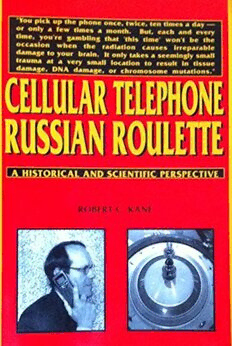
Cellular Telephone Russian Roulette PDF
Preview Cellular Telephone Russian Roulette
Excerpts from the book: "[A] repeated insult or irritation to a particular biological area, such as a small region of the brain, can lead to irreparable damage. [G]iven the existence of energy absorption "hot spots" . . . each damaging exposure to radiofrequency radiation provides a new opportunity that the damage will become permanent." "[W]e can expect that no warning of brain tissue destruction would be provided to a cellular telephone user until the damage was so extensive that the scalp, which absorbs very little energy, sensed heating." "Every action which occurs within that individual’s life during that next week will be affected by the EEG modifications resulting from the portable cellular telephone call." "[E]arlier, researchers have consistently reported that transmitting antennas could not be operated close to the human body—the human head-without violating the safe exposure limits.” "[T]he shape of the skull, thickness of sub-cutaneous fat, muscle layering, and how an individual holds a portable cellular telephone each contributes to make the energy absorption different from one individual to another. The important common factor, however, is that all individuals will absorb a large portion of the radiation." "Today we know that even a single exposure to low level radiofrequency radiation causes damage to the DNA makeup of brain cells." Cellular Telephone Russian Roulette A Historical and Scientific Perspective Robert C. Kane VANTAGE PRESS New York FIRST EDITION All rights reserved, including the right of reproduction in whole or in part in any form. Copyright © 2001 by Robert C. Kane Published by Vantage Press, Inc. 516 West 34th Street, New York, New York 10001 Manufactured in the United States of America ` ISBN: 0-533-13673-3 Library of Congress Catalog Card No.: 00-91593 0 9 8 7 6 5 4 3 2 Contents About the Author vii Introduction ix 1. The Foundations of Radiation Research 1 2. "Hot Spot" Radiation Absorption 41 3. Biological Effects of Radiofrequency Energy 72 4. The Safety Standard Smoke Screen 117 5. Research Labs: The Good, The Bad, and the Biased 154 6. "Damage Control" I—the Birth of Public A Deception 190 7. "Damage Control" II—A Continuing Public Deception 206 About the Author Robert C. Kane has been actively employed in the tele- communications industry for more than thirty years . He holds a BSEE from the Midwest College of Engineering, an MSEE with an emphasis in electromagnetics from the Illinois Institute of Technology and also at the Illinois Institute of Technology, has completed the full course of study and research leading to the Ph.D. in electrical engineering with emphasis in the fields of electromagnetics and solid-state physics. As a research scientist and product design engineer, he has been directly involved with programs and projects for the design and development of portable cell phones, radio frequency mobile radios, microwave telecommunications systems, video display systems, and biological effects research. vii Introduction The EMF and radiofrequency radiation issues are receiving a great deal of attention as of late. Whenever that, attention focuses on radiation from hand-held portable transmitters it invariably includes recent research findings that support the position that there may be an increased risk of disease caused by operating these devices. Most notably, the currently available books, and articles on the RF radiation issue give only slight consideration, if any at all, to the large body of research studies that establish the scientific foundation on which the current findings are based. Typically, the most recent research study will be reported as a revelation to be investigated further while industry continues to treat each such study as if it were isolated in the scientific universe. By keeping the findings uncollected and the data dissembled the financially interested parties can continue business as usual. Business and usual amounts to utilizing their substantial resources to employ the various media to broadcast the industry "belief system." The "belief system" renounces or buries unfavorable scientific findings. This monograph takes a bold step backward by providing a broad view of the scientific landscape that clearly advises us that there is danger here. The bold step back ward is a historical accounting of the research that is available, has been available for forty years or more, and ix has been neglected or buried by an industry that will place its absolute need to sell products above the health and well-being of its own customers. The practice of producing such products can only be viewed as predatory. Never in human history has there been such a practice as we now encounter with the marketing and distributing of products hostile to the human biological system by an industry with foreknowledge of those effects. Unlike the tobacco industry, which could claim ignorance for many decades after its product came into common use, the telecommunications industry has had access to this same scientific research base to which you will now be introduced. In this work you will not find details of the most recent research findings of cancer causation or DNA damage. Those studies, each in its turn, have been well publicized and quickly forgotten as the industry "spin doctors" discounted the importance of each finding. Instead what you will find here is a commentary that presents a litany of past research studies, hundreds of research studies from the 1950s through the mid- 1990s. But don’t be misled. These older studies are equally alarming in their findings of radiation exposure, DNA damage, chromosome damage, tissue damage, radiation absorption, cataract formation, tumor formation, memory loss, motor skills degradation, and more. There are many more studies, hundreds that might have been added, but the point is well made by those that are cited without the need to bludgeon the reader with more than what has been presented. X
